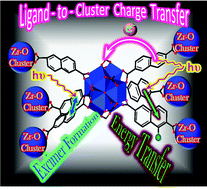Photochemistry of Zr-based MOFs: ligand-to-cluster charge transfer, energy transfer and excimer formation, what else is there?†‡
Abstract
Understanding of the photocatalytic behaviour of Zr-based MOFs is fundamental for the improved design of new and more efficient photocatalysts. The present work describes steady-state and photodynamical studies on the behavior of two MOFs: Zr-2,6-naphthalene dicarboxylate (Zr-NDC) and Zr-4-amino-2,6-naphthalene dicarboxylate (Zr-NADC, 65% NDC/35% NADC) in dichloromethane (DCM) and N,N-dimethylformamide (DMF) suspensions. In the DMF suspension, the Zr-NDC MOF exhibits excimer formation in 280 ps due to the interactions between neighboring linkers. Using the femtosecond transient absorption (fs-TA) technique we have found that the Zr-NADC MOF exhibits a ligand-to-cluster charge transfer (LCCT) event in ∼170 and <100 fs in DMF and DCM, respectively. The Zr-NDC MOF shows similar LCCT in <100 fs in both solvents. The Zr-NADC MOF in DMF suspension shows an energy transfer (ET) from the excited NDC linkers to the NADC ones in 1.1 ps. Flash photolysis experiments demonstrate dominant radiative electron–hole (e−–h+) recombination from two different trap states in 310 ns and 1.3 μs, and 32 ns and 1.0 μs in the photoexcited Zr-NADC and Zr-NDC MOFs in DMF, respectively. Excitation of the NDC linkers in the Zr-NADC and Zr-NDC MOFs in DCM allows for the characterization of the dynamics associated with the charge-separated state and the non-radiative recombination from the trap states (45 ns and 0.3 μs). Direct excitation of the NADC linkers (410 nm) in the Zr-NADC MOF in DCM suspension produces a radiative (e−–h+) recombination in 3.5 μs. Further experiments in the presence of electron donor (N,N,N′,N′-tetramethyl-p-phenylenediamine, TMPD) and acceptor (methyl viologen, MV2+) molecules corroborate the formation of charge separated states in these MOFs. These findings are relevant for understanding the photocatalytic and photonic behaviours of these MOFs.



 Please wait while we load your content...
Please wait while we load your content...